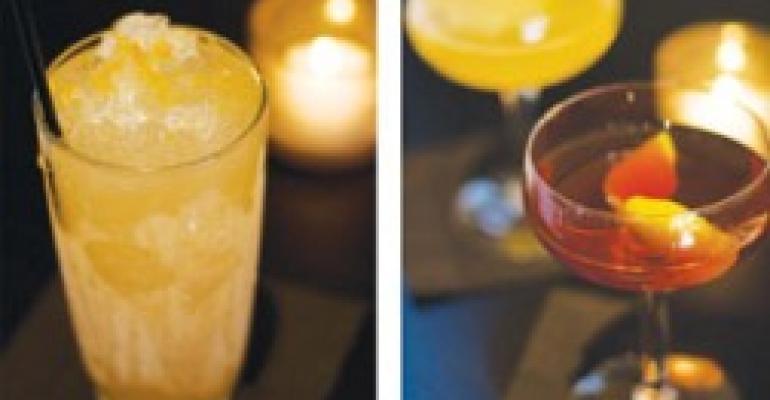Facing a year where the economic downturn could put a damper on indulging in imbibing rituals such as a wine paired with luxurious dinners or creative cocktails, many bartenders are thinking long-term rather than latching on to gimmicky trends to meet continued expectations of sophisticated consumers.
“We don’t want to do some kind of crazy special,” says Chad Ellegood, wine director at Chicago fine-dining establishment Tru. “We’re still in the process of looking for other ways to get people in the door that’s not always for food.”
There’s been buzz about the restaurant’s Inauguration Day bourbon-pairing dinner, and Ellegood says the restaurant is working on other ideas such as wine tasting classes for the after-work crowd.
“The story of how a wine came to Tru, let alone the story about the person who made the wine, that’s fascinating to a lot of people,” Ellegood says about more obscure items on the wine list. “They have stories of how creators came to be in that part of the world that involves a lot of cloak and daggers and smuggling.
“It’s about getting people in the door and keeping us fresh on their minds and taking care of people as best as possible,” he adds.
Deb Blum, owner of Beretta restaurant in San Francisco, stated that a balance between quality and value is what her market is looking for. Consumers still expect to pay about $9 to $10 for drinks made with traditional mixology techniques, and higher-end establishments often charge a dollar or two more.
“Instead of $12 for a drink we might charge $9 or $10 and accept the fact that the bottom line is smaller and a trade-off for long-term sustainability,” Blum says.
“Everything has to be the same exact price,” Alex Day says about his pricing technique. Day, a bartender at New York cocktail lounge Death and Company, also consulted for Lower East Side restaurant Allen and Delancey to revamp their beverage program with a menu that debuted in September of 2008.
Allen and Delancey’s previous pricing was based on what base spirit was used in the drink, which made prices $14 to $16. Day evened out the prices. The cost of ingredients for more expensive drinks are offset by other drinks on the menu that don’t cost as much.
“If you have a base price for your drink, there’s no reason to be decadent,” Day says. “A well-crafted drink doesn’t need an expensive spirit, it needs a good spirit.”
Varying serving sizes can also help operators provide customers with more price choices. Ellegood has noticed that half bottles are becoming more and more popular with customers, so he stocked Tru’s wine cellar with more of the smaller-sized bottles.
Erik Hakkinen, bartender for Seattle bar and restaurant Zig Zag Café, says the restaurant is looking into implementing full and half-measure pours for their more expensive spirit offerings, which also opens up the bar’s options for serving styles.
“We’ll want to do a whole tasting flight with higher-end scotch, bourbon and tequila,” Hakkinen says.
Some 70 percent of beverage sales come from cocktails served at Zig Zag, he adds. He explains that the 1- or 2-ounce pours can make the pricier spirits more approachable and help “cultivate that younger crowd of rookie drinkers with potential to become considerably more mature drinkers.” To Blum, rather than focusing only on value, the ability to include unusual or unique items, whether a wine or a cocktail ingredient, adds to a guest’s experience.
“Experience for guests adds to value, so we search for unusual items that are better priced that add to guest experience,” Blum says.
Following the locavore and slow-foods traditions popular in San Francisco, Beretta’s bartenders use plenty of local ingredients as well as organic sweeteners such as agave nectar, honey and maple syrup in their cocktails. The restaurant also takes advantage of purchasing from sources like primary suppliers to buy in bulk and save further.
“We’ve got a lot of local liquor and a lot of distilleries popping up, and there’s a lot of local wine and beer,” Hakkinen says about Seattle’s local products.
“I think there are marketing ploys such as specials and that kind of thing,” Day says, referring to ways to attract customers during tough economic times. “But as a business owner, it’s a personal decision. It’s really about understanding your market because there are so many varied markets and consumers.”

